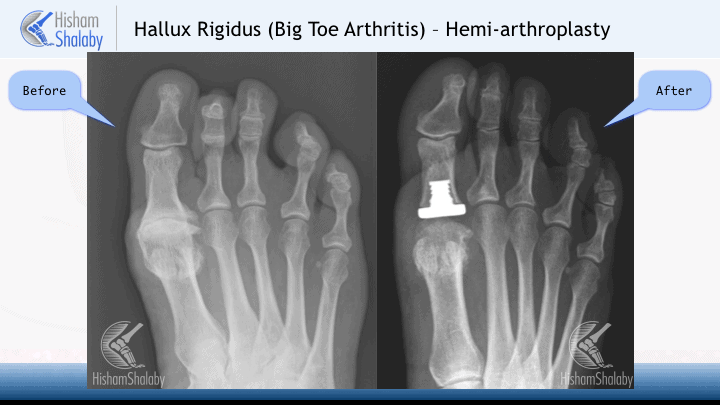Hemiarthroplasty of 1st MTP joint
Replacement of the big toe joint is one of the treatment modalities for treating Hallux Rigidus or arthritis of the big toe.
What does the operation involve?
The operation is done as a day case, but come prepared in case you need to stay overnight.
The operation is performed under general anaesthetic and nerve block (which means numbing the nerves of the foot).
The operation involves one incision over the base of the big toe. The abnormal extra bone around the joint is trimmed to free the joint. Half of the joint is removed and replaced by a metal button-shaped prosthesis.
You see the physiotherapist after or before your operation and they give you crutches if needed.

Your post-operative period
- You must keep your foot raised for the first two weeks and when necessary afterwards
- You can put your full weight on your foot
- Use crutches if needed
- Exercise big toe when dressings are removed
- The swelling may last for up to six months.
Your follow-up
- Nurse-led clinic at two weeks to reduce dressing and remove stitches
- Consultant clinic at six weeks for x-rays
- Off work for up to six weeks, depending on your job
- No driving for up to six – eight weeks.
What are the possible complications?
- Infection
- Ongoing pain
- Loosening of the implant
- Need for further revision surgery
- Sensitive or painful scar
- Big toe permanent numbness
- Joint stiffness
- Clots in the leg (DVT)
- Clots in the lung (PE)
- Chronic Regional Pain Syndrome
Smoking, diabetes, rheumatoid arthritis or being on steroids or blood-thinning medication increases possible risks significantly.
Fusion vs Replacement
The gold standard treatment of the advanced wear and tear in the big toe joint remains the fusion. However, the fusion causes loss of the movement completely and can leave the patient with some limitations. The recovery after the fusion also usually takes a bit longer as we wait for the 2 sides of the joint to heal together.
The replacement was therefore thought of as an alternative is selected cases. The full replacement of the joint has yielded discouraging results in the literature. It also entails resection of a lot of bone and therefore makes any future surgery in this area more difficult.
The hemi-arthroplasty means replacement of only half the joint. We are performing more of this procedure now with very good results in selected cases.
